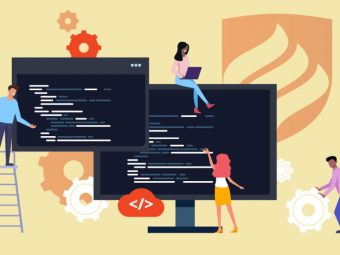Unreal Engine 5 The Complete Beginners
Tags: Unreal Engine
Learn Video Game Development & How To Design a Game From Scratch Using UE5
Last updated 2022-01-10 | 4.7
- Learn game development using Unreal Engine 5- Build realistic looking environments for games to take place in
- Define custom inputs and movements to control characters
What you'll learn
* Requirements
* Recommended: Desktop PC with Windows 7 (or later) 64-bit or a Mac with Mac OS X 10.9.2 or later* Recommended: 8 GB RAM
* Recommended: Quad-core Intel or AMD processor
* 2.5 GHz or faster
* Recommended: DirectX 11 compatible video card
* Unreal Engine 5 will run on desktops and laptops with specifications under these
* but performance may be affected
Description
Learn game development with Unreal Engine 5. UE5 is the industry-leading 3D game design software that the professionals use to create today’s top games. Start your journey towards getting paid to make video games today!
Learn Video Game Development with this Unreal Engine 5 Course for Beginners
Begin your game development career with possibly the most up-to-date game dev course on the internet - Unreal Engine 5: The Complete Beginner's Course. Every lecture in this course was filmed using version 5 of the Engine.
When I began trying to learn Unreal Engine, I found a lot of information, but it was unstructured and lacked detail. So I created this course to provide what others lacked - structure and detail. The course is laid out very carefully so that you can go into it knowing absolutely nothing, and then, little by little, each lecture builds upon the previous lectures, so that every time you learn something new, you already have all the knowledge you need to learn that new thing without any confusion.
Unlike other courses, it covers the fundamentals in detail, so by the end you should have a thorough understanding of all the basics of Unreal Engine and be fully prepared to move on to more intermediate topics. Depending on your goals, this might not be for you. This course was designed for those who want to learn as much about Unreal Engine 5 as possible. If you’re just looking to have a bit of fun and to tinker around a little bit, then this might not be the right course for you. But, if you’re interested in getting really good, possibly becoming an indie developer or even working for a major studio, then I strongly believe that this is the best course for you to start with. This course will teach you the knowledge that normally falls through the cracks.
At the end of each section, there are a series of tutorial videos that provide an opportunity to apply the concepts learned in that section. These tutorials will walk you through the process of making a working game, from start-to-finish, step-by-step.
This course covers the fundamentals that other courses skip, causing you to get confused as you try to learn more advanced topics. The course will cover the following topics in thorough detail:
Projects & Levels
Actor Types
Meshes & Brushes
Lighting
Materials
Characters & Input
Collisions
Blueprint Logic & Data
User Interfaces
Audio
Develop Games Using Cutting-Edge Game Design Software and Run Them on a State-of-the-Art 3D Game Engine
The Unreal Engine has won the “Best Game Engine” award several times from various organizations, including the Develop Industry Excellence Awards and Game Developer Magazine.
The Unreal Engine has been used to develop many blockbuster games and game franchises including Fortnite, BioShock, Gears of Wars, Splinter Cell, Rainbow 6, Borderlands, Dishonored, Mass Effect, Batman: Arkham Asylum, and hundreds more.
For years, the Unreal Engine was only affordable for large companies, but now, Unreal Engine 5 is completely free to use, as long as you agree to pay Epic Games 5% of your game sales over $1 million.
Learn Unreal Engine 5 in this Video Game Design Course
In this course, you will learn the fundamentals of game development using the Unreal Engine 5 through a series of 62 lectures and 15 tutorials. By the end of the course, you will have built an entire demo game from scratch.
The course will start from scratch and programming knowledge is not required, so anyone with basic computer skills can jump in and begin their Unreal Engine 5 training! For those who learn better with closed captions, 100% of the captions are human transcribed, not auto-generated.
The first part of the course will help you get the Unreal Engine 5 up and running and will introduce you to the basic concepts of game development using the Engine. Next, you will learn all the skills you need to craft beautiful environments to stage your games in. Then, you will learn how to script logic for your games so you can define game rules and behaviors, keep track of data such as health and inventory, and create playable characters. You will learn about collisions and damage, key concepts for any action game. You will learn how to create user interfaces using the UMG Editor, so you can add things like menus, load screens, and HUDs to your game. And finally, you will learn how audio works within the Engine so you can add music, dialogue, and sound effects to your game.
Upon completion of the course, you will have the skills necessary to translate ideas for games into playable games that use environments you sculpt and logic that you define, and you will understand how to make a game in Unreal Engine 5.
Who this course is for:
- This video game development course is for absolute beginners who are interested in making games & learning how to design a game from scratch using UE5
- Designed for those who want to become professionals using Unreal Engine 5
- No programming experience required
Course content
9 sections • 78 lectures
Introduction Preview 09:54
Learn about what makes this course special. Learn the history of the Unreal Engine, the licensing model that allows anyone to use the Engine with no upfront costs, and an overview of what this course will cover. Then, see the demo of the sample game that we will be building in the tutorials of this course.
Registration & Installation Preview 03:01
How to register an account with Epic Games and how to download and install the most recent version of Unreal Engine 5.
Projects Preview 09:59
The basics of Projects and how to create a new project. The Epic Games Launcher, Unreal Project Browser, template projects, the difference between "Maximum Quality" and "Scalable 3D or 2D", Starter Content, and immersive mode (full screen).
Levels Preview 03:55
Definition of a Level in the context of the Unreal Engine. How to create a new Level. What is the difference between choosing "Default", "TimeOfDay", "VR-Basic", and "Empty Level". How to open and save Levels.
Actors Preview 06:12
Definition of an Actor in the Unreal Engine. Overview of some of the basic types of Actors such as Static Meshes, Geometry Brushes, and Lights.
Level Editor Overview Preview 08:38
What is the difference between the Unreal Engine and the Unreal Editor. The different parts of the Level Editor - Viewport, Toolbar, Content Browser, World Outliner, and Details Panel. How to customize the interface.
Select Editing Mode Preview 04:21
How to place Actors into a Level. The six different editing modes of the Editor. The Create menu and the different categories of the Place Actors Panel - Basic, Recently Placed, Lights, Shapes, Cinematic, Visual Effects, Geometry, Volumes, and All Classes.
Viewport I - Navigating Within the Viewport Preview 07:00
The three main ways to navigate within the Viewport - mouse navigation, WASD navigation, and Maya navigation. How to focus the camera on an object. How to tumble, orbit, dolly, zoom, track, and pan. How to adjust camera speed.
Viewport II – Moving, Rotating, and Scaling Preview 08:26
How to use the translation, rotation, and scaling widgets. How to select multiple Actors and move them all at once. How to copy Actors. How to change the pivot point of an Actor. What is the difference between world space vs local space.
Viewport III – Snapping Preview 08:01
How to use snapping to perfectly align your Actors with one another within your Level. What is the difference between Surface Snapping, Grid Snapping, Rotation Snapping, Scale Snapping, and Vertex Snapping. The "Rotate to Surface Normal" and "Surface Offset" settings. What are snap sizes.
Viewport IV – Different Ways To View Your Level Preview 11:10
What is Immersive Mode. What is the difference between the View Modes - Lit, Unlit, and Wireframe. What is the difference between a perspective view and an orthographic view. The Show Flags setting, Game View, and piloting Actors within the Viewport. The Viewport Options menu including Realtime, Show FPS, Show Stats, Show Toolbar, Field Of View, Far View Plane, Screen Percentage, and Bookmarks.
Content Browser I - Overview & Finding Content Preview 09:32
The Sources Panel, Asset Window, Collections Panel, searching the Content Browser, and breadcrumbs. The Content Drawer, Dock in Layout button and search filters. What is the difference between static collections vs dynamic collections.
Content Browser II – Adding, Importing, and Saving Preview 03:43
The Add New, Import, and Save All buttons of the Content Browser. How to use the "Add Feature or Content Pack" feature. How to migrate assets in Unreal Engine 5.
Content Browser III – The Settings Menu Preview 06:10
The different options of the Settings menu of the Content Browser such as "Show Developers Folders", "Show Plugins Content", "Show Engine Content", "Show Collections", and "Thumbnail Edit Mode".
Details Panel I - Details Panel Interface Preview 06:41
How to use the lock button in the Details Panel. How to quickly find properties within the Details Panel. What is the Property Matrix. The options in the Settings menu of the Details Panel such as "Show Only Modified Properties", "Show All Advanced Details", and "Show Child on Category Match". How to add properties to a Favorites list.
Details Panel II - The Transform Category Preview 05:44
How to move, rotate, and scale Actors using the Transform category of the Details panel. What is the difference between transforming relative to an Actor’s parent and transforming relative to the world. What is the difference between the Static vs Stationary vs Moveable mobility settings.
World Outliner Preview 09:35
How to use the World Outliner to organize and quickly find the Actors in your Level. How to group, ungroup, lock, and unlock Actors.
Static Meshes Preview 10:26
What is the difference between a static mesh vs skeletal mesh. The properties of the Physics category of the Details Panel including Simulate Physics, Enable Gravity, Linear Damping, Angular Damping, and Constraints.
Brushes Preview 12:19
The difference between Geometry Brushes vs Meshes. The Brush Setting properties such as Brush Type, Brush Shape, Outer Radius, Inner Radius, Sides, Tessellation, Align to Side, Hollow, Wall Thickness, and Cap Z. What is the difference between the Additive and Subtractive Brush types. The stair Brushes and their properties such as Linear Stair, Curved Stair, Spiral Stair, Step Height, Step Width, Step Thickness, Number of Steps, Add to First Step, Angle of Curve, Sloped Floor, and Sloped Ceiling.
Materials Preview 06:40
What are Materials, Textures, and Elements. The Surface Materials, Geometry, and Surface Properties categories in the Details panel. The "Select All Adjacent Surfaces" property, the U-axis and V-axis
Lights Preview 12:42
The five types of Light Actors in the Unreal Engine - the Directional Light, Point Light, Spot Light, Rect Light and Sky Light. How to "build" the lighting and why this is necessary. The properties of Lights such as Intensity, "Light Color", "Use Temperature", "Affects World", "Cast Shadows", "Indirect Lighting Intensity", "Attenuation Radius", "Source Radius", "Source Length", "Inner Cone Angle", "Outer Cone Angle", "Source Type", "Source Angle", "Source Soft Angle", "Volumetric Scattering Intensity", "Soft Source Radius", "Barn Door Angle", "Barn Door Length", "Source Texture", "SLS Captured Scene", "Sky Distance Threshold", and "SLS Specified Cubemap". How to use the Color Picker. What is raytracing.
Atmosphere & Clouds Preview 16:03
What is the difference between Atmospheric Fog vs Sky Atmosphere Actor. What is the difference between Sky Sphere vs Volumetric Clouds. What are the Atmosphere Sun Light and Cast Shadows on Clouds properties of the Directional Light. The properties of the Sky Atmosphere Actor including Atmosphere Height, MultiScattering, Transform Mode, Planet Top at Absolute World Origin, Ground Radius, Ground Albedo, Rayleigh scattering, and Mie scattering. The properties of the Volumetic Cloud Actor including Layer Bottom Altitude, Layer Height, and Planet Radius.
Player Start Preview 02:37
The Player Start actor, Bad Size label, "Play From Here" option, and "Spawn Player At" option.
Components Preview 06:15
What are Components in Unreal Engine 5. How to use the Rotating Movement Component. Definition of a Root Component and the Pivot Translation property.
Volumes Preview 09:54
The different types of Volumes such as the Blocking Volume, Camera Blocking Volume, Trigger Volume, Pain Causing Volume, Kill Z Volume, Physics Volume, and Water Volume. Properties related to Volumes such as Damage Per Second, Pain Interval, Damage Type, Entry Pain, Terminal Velocity, Priority, and Fluid Friction.
Tutorial 1 - Creating the Sky Preview 06:20
In this tutorial, we create a new project and a new Level and construct the sky for the Level.
Tutorial 2 - Creating the Playing Area Preview 06:41
In this tutorial, we construct the playing area for our game, using Brushes, Meshes, and Materials.
Tutorial 3 - Building the Inner Structures of the Level Preview 14:30
In this tutorial, we add the internal structures for our Level, including walls, platforms, and houses.
Introduction to Blueprints Preview 12:21
Learn about Level Blueprints, the Level Blueprint Editor, Blueprint Classes, the Event Graph, the Event BeginPlay node, Event Tick node, Delay node, Function Nodes, input pins, execution pins, Quit Game function, Quit Preference variable, and how to compile a Blueprint.
Variables Preview 14:36
What variables are and how to create and edit them using the My Blueprint tab. What data types are and the difference between types such as Boolean, Byte, Integer, Integer64, Float, Double, Text, String, Name, Vector, Rotator, and Transform. Learn about the different properties of variables such as Variable Name, Variable Type, Tooltip, Private, Category, Slider Range, Value Range, Instance Editable, Blueprint Read Only, Replication, and Replication Condition.
Functions Preview 09:48
What functions are and how to create them. What is the Return node and Append node. The properties of functions in the Unreal Engine such as Description, Category, Keywords, Compact Node Title, Call In Editor, and Access Specifier. What is the difference between public vs private functions. What is the difference between pure vs impure functions.
Flow Control I Preview 08:49
How to control the flow of execution in Blueprints using flow control nodes such as the Branch node, Delay node, Do N node, DoOnce node, DoOnce MultiInput node, and FlipFlop node.
Flow Control II Preview 08:28
Continuation of the discussion on flow control nodes such as the ForLoop node, ForLoopWithBreak node, Gate node, MultiGate Node, Retriggerable Delay function, Sequence node, WhileLoop node, and Switch nodes.
Accessing Actors Within the Level Blueprint Preview 05:19
How to access the Actors of a Level within a Level Blueprint. Learn about the Set Visibility function, New Visibility property, Propagate to Children property, OnActorBeginOverlap Event and OnActorEndOverlap Event.
Timelines Preview 16:56
How to use Timelines, the Timeline Editor, tracks, keys, curves, the Set Intensity node, the Create External Curve feature, Use Last Keyframe option, AutoPlay option, Ignore Time Dilation option, Replicated option, Tick Group option, Play pin, Stop pin, Reverse pin, Finished pin, and Direction pin. How to use the Lerp node.
Blueprint Classes Preview 12:56
What Blueprint Classes are and how to use them. Learn about the Construction Script, Toggle Visibility function, and making variables editable.
Tutorial 4 - Building the Elevator Platform Preview 10:17
In this tutorial, we use Blueprints to create our first custom Actor - a platform that will continually move up and down.
Tutorial 5 - Creating the Enemies Preview 06:07
In this tutorial, we create the Blueprint for the enemies in our game.
Tutorial 6 - Creating a Rotating Door Preview 07:45
In this tutorial, we use a Timeline to animate the opening of a door. Unlike the previous Timelines we made, which dealt with translational movement, we use this Timeline to create rotational movement.
Game Modes Preview 06:31
Game Modes and Game Mode properties such as Use Seamless Travel, Pauseable, Start Players as Spectators, Delayed Start, Minimum Respawn Delay, Default Player Name, Player State Life Span, Allow Tick Before Begin Play, and Start With Tick Enabled. How to set game default classes such as the Default Pawn Class. How to set a Default Game Mode.
Pawns Preview 04:53
Pawns, Cameras, the Spring Arm component, and the Target Arm Length property.
Characters Preview 06:57
Characters, the Capsule Component, Arrow Component, Skeletal Mesh Component, and the CharacterMovement component. Character properties such as Gravity Scale, Max Acceleration, Braking Friction Factor, Use Separate Braking Friction, Crouched Half Height, Default Land Movement Mode, Default Water Movement Mode, Mass, Max Step Height, Walkable Floor Angle, Jump Z Velocity, and Air Control.
Controllers Preview 07:58
Using Controllers to control Character input. Difference between the PlayerController vs the AIController. How to use the Get Player Character function.
Input Mapping Preview 03:41
How to use Input Mapping. What is the difference between Action Mappings vs Axis Mappings.
Tutorial 7 - Creating a Playable Character Preview 15:44
In this tutorial, we set up a Character and create inputs to control that Character. Learn about character movement, the Add Controller Pitch Input function, Add Controller Yaw Input function, Use Controller Rotation Pitch property, Use Controller Rotation Yaw property, Get Control Rotation function, and Get Right Vector function. We also add pause functionality to the game and the ability to open the end of Level door by pressing a button.
Collisions I - Collision Volumes Preview 15:33
How to use collision volumes such as a Box Collision, Capsule Collision, or Sphere Collision. How to define collision volumes in the Static Mesh Editor. What is the difference between a Simple Collision vs Complex Collision. What are K-DOP collisions such as 10DOP-X Simplified Collision, 10DOP-Y, 10DOP-Z, 18DOP, and 26DOP. How to use the Auto Convex Collision tool. The Collision Complexity property and its options such as "Use Simple Collision As Complex" and "Use Complex Collision As Simple".
Collisions II - Collision Events Preview 13:36
What are collision properties such as Simulation Generates Hit Events, Generate Overlap Events, Collision Enabled, Physics Collisions Only, Query Collisions Only, Object Type, and Can Character Step Up On. What is the difference between ECB Yes, ECB No, and ECB Owner. What is the difference between WorldDynamic vs PhysicsBody. How to use collision presets such as BlockAll, OverlapAll, and OverlapAllDynamic.
Collisions III - Causing Damage Due to Collisions Preview 11:27
How to use the Event Hit node and its many pins such as My Comp, Other, Self Moved, Hit Location, Hit Normal, Normal Impulse, and Hit pin. How to use the Apply Damage node and its pins such as Damaged Actor, Base Damage, and Damage Type Class. How to use the Event AnyDamage node.
Tutorial 8 - Adding a Damage System to the Game Preview 07:40
In this tutorial, we add collision and damage functionality to our game.
Tutorial 9 - Creating the Orb Item Preview 06:39
In this tutorial, we create the orbs that the player will need to collect to get through the final door. We also make it so that the player will be required to stand directly in front of the door to open it.
UMG Overview Preview 06:35
The definition of UMG and how it is used to create menus and HUDs. Learn about Widget Blueprints, Create Widget node, Owning Player pin, Add to Viewport node, Remove From Parent node, and Hierarchy window.
Root Widget Preview 05:33
What is the Root Widget and its properties such as Color and Opacity, Foreground Color, Is Focusable and Background.
Canvas Panel Preview 05:30
How to use the Canvas Panel, Anchors, Anchor Medallions, Size to Content property, and the ZOrder property.
Horizontal Box and Vertical Box Preview 04:21
How to use the Horizontal Box and Vertical Box and their properties such as Padding, Size, and Alignment.
Grid Panel & Uniform Grid Panel Preview 06:04
What is the difference between the Grid Panel vs Uniform Grid Panel. How to use the Uniform Grid Panel and its properties including Slot Padding, Minimum Desired Slot Width, and Minimum Desired Slot Height. How to use the Grid Panel and its properties such as Row Span, Column Span, Layer, and Nudge.
Common Widget Properties Preview 09:55
The properties that are common to all widgets, including Is Enabled, Tool Tip Text, Visibility, Hit Test Invisible, Performance, Is Volatile, Clipping, Clip to Bounds, Flow Direction Preference, Translation, Scale, Shear, Angle, and Pivot.
Visual Designer Preview 06:19
How to use the Visual Designer. What is the difference between a Layout Transform vs Render Transform. Learn about localization features such as Preview Game Language.
Text Widget Preview 05:00
The Text Widget and its properties such as Font, Shadow Offset, Shadow Color, Justification, Strike Brush, Min Desired Width and Auto Wrap Text.
Button Widget Preview 06:19
What is the Button Widget and its properties including Style, Image, Image Size, Draw As, Normal Padding, and Pressed Padding. The difference between the three events of the Button Widget - OnClicked, OnPressed, and OnReleased.
Border Widget & Image Widget Preview 01:41
How to use the Border Widget and Image Widget.
Progress Bar Widget Preview 06:29
The Progress Bar Widget and its properties such as Percent, Fill Color, Background Image, Tiling, Bar Fill Type, Enable Fill Animation, and Is Marquee. How to bind the Percent property to a variable.
Check Box Widget Preview 05:48
Learn about the Check Box Widget and its properties such as Checked State, Horizontal Alignment, Check Box Type, and Padding.
Scale Box & Size Box Preview 05:56
The Scale Box and its properties such as Stretch Direction and Ignore Inherited Scale. The Size Box and its properties including Width Override and Height Override.
Tutorial 10 - Creating the HUD Preview 06:38
In this tutorial, we create a HUD for our player, so they can keep track of their health and the number of orbs they have collected.
Tutorial 11 - Damage Tint and Collect Item Tint Preview 07:01
In this tutorial, we add some functionality so that when they player receives damage, the screen will briefly flash red, and when the player collects an orb, the screen will briefly flash blue.
Tutorial 12 - Restrict Door Opening and Creating a Pause Menu Preview 08:27
In this tutorial, we modify the end of Level door logic so that the player can only open the door once they have collected all three orbs. We also display a message in the HUD to inform the player of this rule when they get close to the door. Then we create a pause menu.
Tutorial 13 - Game Over and Win Screen Menus Preview 10:50
In this tutorial, we create a game over menu for when the player dies and a win screen menu for when they beat the game.
Audio I - Audio Overview & Sound Waves Preview 11:05
Learn about Sound Waves and their properties. The AmbientSound actor and its properties including Is UISound, Auto Activate, Looping, Compression Quality, Subtitles, Spoken Text, Mature, Manual Word Wrap, Envelope Follower Attack Time, Envelope Follower Release Time, Is Ambisonics, Subtitle Priority, and Comment. What is the difference between Sound Groups vs Sound Classes. How to use the Play Sound node, Play Sound At Location node, and Spawn Sound Attached node.
Audio II - Sound Cues Preview 07:02
Sound Cues, the Wave Player node, Looping node, Delay node, Doppler node, Modulator node, Oscillator node, Mixer node, Concatenator node, Random node, Branch node, and Switch node.
Audio III - Attenuation Preview 05:25
What is Attenuation and Attenuation properties such as Override Attenuation, Radius, Falloff Distance, Attenuation Shape, and Attenuation Curve.
Audio IV - Importing and Converting Audio Preview 02:10
How to import and convert audio to use in Unreal Engine 5.
Tutorial 14 - Adding Audio to the Game Preview 04:35
In this tutorial, we add audio to our game. We add some outdoors noises, like wind and birds chirping, we add some fire noises, and we add some background music that will start playing once the player reaches a certain point in the Level.
Downloading Content From the Epic Games Launcher Preview 03:20
How to download content from the Epic Games Marketplace and Quixel Bridge.
Importing 3D Objects From the Internet Preview 05:42
How to import 3D objects from the internet into Unreal Engine 5. Websites to download and/or buy 3D content from.
Packaging Preview 05:31
How to package projects and the various settings available when doing so, such as Build, Build Configuration, Staging Directory, Full Rebuild, Use Pak File, and Create compressed cooked packages. The difference between the Build Configuraton settings Development, Shipping, DebugGame, and Test. How to encrypt and sign pak files.
Tutorial 15 - Packaging the Game Preview 02:22
In this tutorial, we package and export the demo game so that it can be played outside of the Editor.








 This course includes:
This course includes:
![Flutter & Dart - The Complete Guide [2022 Edition]](https://img-c.udemycdn.com/course/100x100/1708340_7108_5.jpg)















